Dr. Oz's Anti-Aging Checklist
By Dr. Mehmet Oz
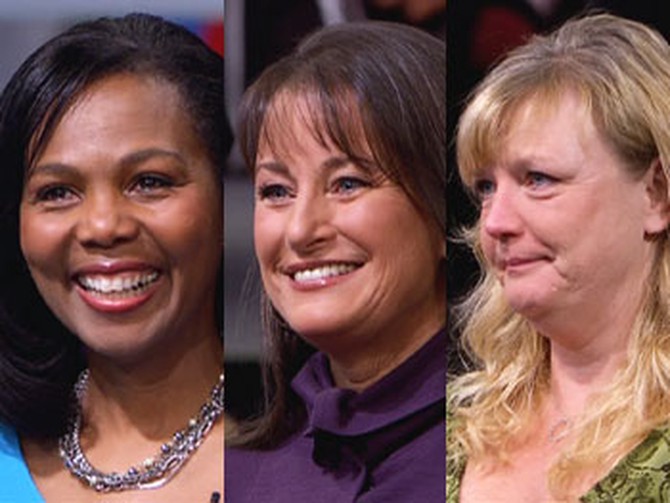
Are you looking for ways to get healthy and peel the years off your body? Dr. Oz and Dr. Roizen are back with the ultimate anti-aging checklist. Don't wait until you're falling apart—change the way you look at life and start your path to better health today!
Barbara (on the left) is 60, but her body is much younger. After 22 years of yoga, regular belly-dancing classes and her passion for reading and writing, Dr. Roizen says Barbara's "real age" is 48.
Sandra (in the middle) is 63, but her "real age" is just 50. Dr. Roizen says that through meditation, plenty of sleep, a balanced diet and making time for her passion of riding horses, Sandra has shaved 13 years off her calendar age. Finding that passion in your life is hugely important in staying young, Dr. Roizen says. "It's about an 8-year effect," he says. "It's a major factor."
Unlike Barbara and Sandra, Laura (on the right) is not living a healthy lifestyle. She smokes, doesn't exercise and doesn't deal well with her stress. She is 44, but her "real age" is 60. "Temporarily," Dr. Roizen says. "You can still get younger—that's the good news."
The first step is to make the changes on this checklist. "The things we'll show here, just in the right amounts, can take a dramatic amount of aging off of you," Dr. Oz says.
Barbara (on the left) is 60, but her body is much younger. After 22 years of yoga, regular belly-dancing classes and her passion for reading and writing, Dr. Roizen says Barbara's "real age" is 48.
Sandra (in the middle) is 63, but her "real age" is just 50. Dr. Roizen says that through meditation, plenty of sleep, a balanced diet and making time for her passion of riding horses, Sandra has shaved 13 years off her calendar age. Finding that passion in your life is hugely important in staying young, Dr. Roizen says. "It's about an 8-year effect," he says. "It's a major factor."
Unlike Barbara and Sandra, Laura (on the right) is not living a healthy lifestyle. She smokes, doesn't exercise and doesn't deal well with her stress. She is 44, but her "real age" is 60. "Temporarily," Dr. Roizen says. "You can still get younger—that's the good news."
The first step is to make the changes on this checklist. "The things we'll show here, just in the right amounts, can take a dramatic amount of aging off of you," Dr. Oz says.
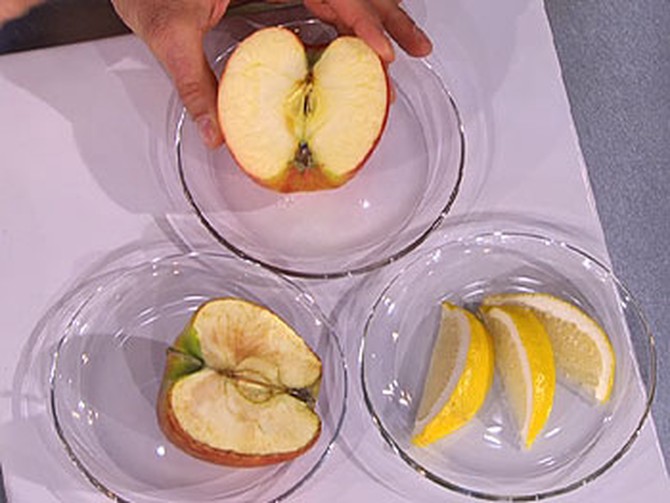
Your change to a newer, healthier life starts in your refrigerator. The first thing you need in there is plenty of foods rich in antioxidants.
But what are antioxidants? Why are they so good for anti-aging?
To explain, Dr. Oz compares apples to apples—one half of this apple was sprinkled with lemon juice and the other was not. While the lemony half remains new and crisp-looking, the untreated half becomes brown and shriveled because of exposure to oxygen, also called oxidation. "The same thing happens to our skin, to our heart, to our eyes," Dr. Oz says. "All of our bodies need to have the antioxidants."
As their name implies, antioxidants do to your body what the lemon juice does to an apple—help prevent the damage caused by oxygen exposure.
While lemons do have some anti-aging benefits—similar to onions—Dr. Oz says there are several foods that are much more potent.
But what are antioxidants? Why are they so good for anti-aging?
To explain, Dr. Oz compares apples to apples—one half of this apple was sprinkled with lemon juice and the other was not. While the lemony half remains new and crisp-looking, the untreated half becomes brown and shriveled because of exposure to oxygen, also called oxidation. "The same thing happens to our skin, to our heart, to our eyes," Dr. Oz says. "All of our bodies need to have the antioxidants."
As their name implies, antioxidants do to your body what the lemon juice does to an apple—help prevent the damage caused by oxygen exposure.
While lemons do have some anti-aging benefits—similar to onions—Dr. Oz says there are several foods that are much more potent.
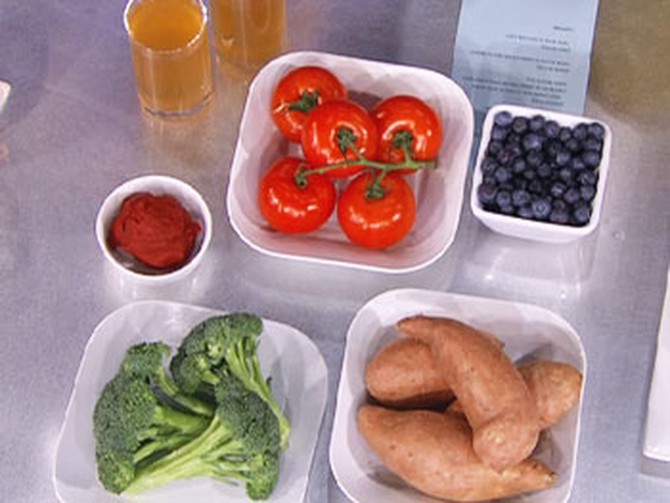
Dr. Oz says one of his favorite anti-aging foods are blueberries. You can tell blueberries are chockfull of antioxidants because of their dark color. "All foods with dark colors in them have some of these really protecting antioxidant chemicals in them," he says. "Blueberries lead the charge."
Other good anti-aging foods include sweet potatoes, broccoli and tomatoes. "[When eating] tomatoes, heat them up a little bit and put a little oil in them. It makes it easier to absorb the lycopene," Dr. Oz says. "Lycopene is another antioxidant, but it has additional benefits as well, which are particularly valuable for the heart."
While he's mentioned many of these antioxidant-rich foods before, Dr. Oz is ready to introduce a new entry to his hall of fame—the acai (pronounced "AH-sigh-EE"), a small fruit from South American rainforests that is often found in the United States in juice. "It has twice the antioxidant content as a blueberry, so it's a wonderful alternative," Dr. Oz says. "Look at the food label and make sure they don't have too many carbohydrates in there. It's available in all major stores now. It's just sort of breaking through."
Get the facts about Oprah and acai berry products
Dr. Oz says you should eat about five servings of antioxidant-rich foods a day.
Other good anti-aging foods include sweet potatoes, broccoli and tomatoes. "[When eating] tomatoes, heat them up a little bit and put a little oil in them. It makes it easier to absorb the lycopene," Dr. Oz says. "Lycopene is another antioxidant, but it has additional benefits as well, which are particularly valuable for the heart."
While he's mentioned many of these antioxidant-rich foods before, Dr. Oz is ready to introduce a new entry to his hall of fame—the acai (pronounced "AH-sigh-EE"), a small fruit from South American rainforests that is often found in the United States in juice. "It has twice the antioxidant content as a blueberry, so it's a wonderful alternative," Dr. Oz says. "Look at the food label and make sure they don't have too many carbohydrates in there. It's available in all major stores now. It's just sort of breaking through."
Get the facts about Oprah and acai berry products
Dr. Oz says you should eat about five servings of antioxidant-rich foods a day.
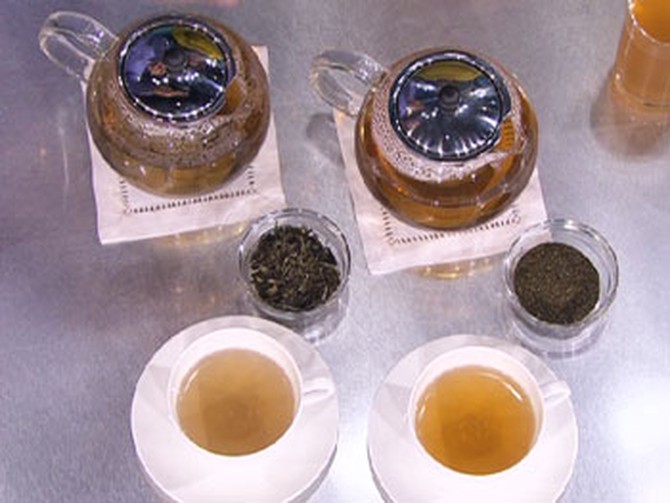
While Americans' number one source of antioxidants is from coffee, Dr. Oz says there are better hot beverages out there, like green tea.
Another great tea option is white tea. "It's not new—it's very old—and [has] been used for centuries for healing purposes."
White tea is from the same plant as green tea, but it's produced in a different way. While green tea is made of leaves dried to the point where the tea will be dark in color, white tea is made from an immature plant bud that isn't dried at all. Instead of steeping the leaves, white tea is steamed. Dr. Oz says the potential for medicinal benefits of white tea—beyond a very small amount of caffeine as compared with other kinds of tea and coffee—comes from this lack of drying.
Dr. Oz says you should drink about four cups of green or white tea a day.
Another great tea option is white tea. "It's not new—it's very old—and [has] been used for centuries for healing purposes."
White tea is from the same plant as green tea, but it's produced in a different way. While green tea is made of leaves dried to the point where the tea will be dark in color, white tea is made from an immature plant bud that isn't dried at all. Instead of steeping the leaves, white tea is steamed. Dr. Oz says the potential for medicinal benefits of white tea—beyond a very small amount of caffeine as compared with other kinds of tea and coffee—comes from this lack of drying.
Dr. Oz says you should drink about four cups of green or white tea a day.
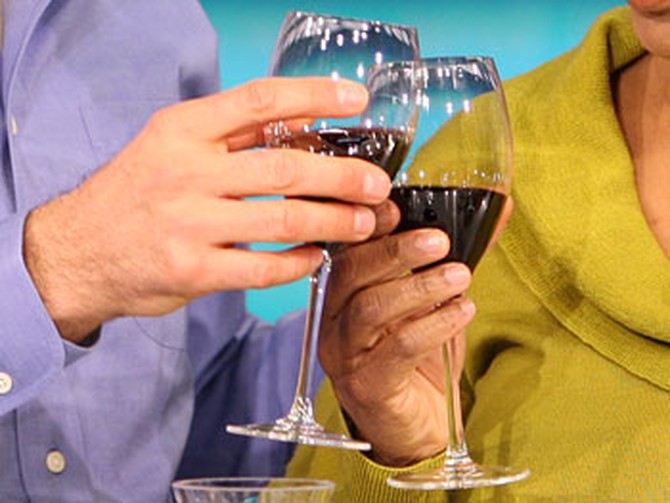
One of the most talked about pieces of dietary news to arise in recent years is that red wine is good for your health. Dr. Oz says part of the reason is the alcohol and part is resveratrol, a powerful antioxidant that comes from the skins of grapes. Vintners add the grape skins back to make red wine, but they don't do the same process for white wine—so white wine has no resveratrol benefit.
Learn the truth about Oprah, Dr. Oz and claims about resveratrol.
"Resveratrol does one other thing," Dr. Oz says. "It turns on a system in your body that prevents your cells from aging. Now think about it. Where do they grow these grapes? On trees on hillsides, right? It's not a very hospitable environment. So those grapes are sending a signal to us that life might not be so good, so why not turn on that cellular chemistry that you have that allows you to live longer and better? That's why we think this has a benefit."
If you don't want the alcohol, Dr. Oz says you can get some resveratrol from Concord grape juice or other dark grape juices, but you won't get as much benefit as you would from red wine. "Eighty percent of the benefit of the wine is actually the alcohol, and 20 percent is the resveratrol," Dr. Oz says. "So it's the combination that makes red wine so valuable."
Of course, moderation is the key when drinking to your health. Dr. Oz says most people should drink about one glass of red wine a day, though some men can drink slightly more because males metabolize alcohol more effectively than females.
Learn the truth about Oprah, Dr. Oz and claims about resveratrol.
"Resveratrol does one other thing," Dr. Oz says. "It turns on a system in your body that prevents your cells from aging. Now think about it. Where do they grow these grapes? On trees on hillsides, right? It's not a very hospitable environment. So those grapes are sending a signal to us that life might not be so good, so why not turn on that cellular chemistry that you have that allows you to live longer and better? That's why we think this has a benefit."
If you don't want the alcohol, Dr. Oz says you can get some resveratrol from Concord grape juice or other dark grape juices, but you won't get as much benefit as you would from red wine. "Eighty percent of the benefit of the wine is actually the alcohol, and 20 percent is the resveratrol," Dr. Oz says. "So it's the combination that makes red wine so valuable."
Of course, moderation is the key when drinking to your health. Dr. Oz says most people should drink about one glass of red wine a day, though some men can drink slightly more because males metabolize alcohol more effectively than females.
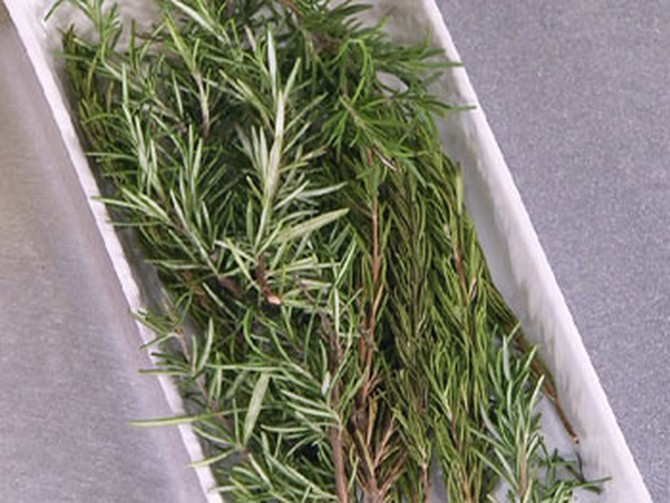
Did you know your spice rack is full of anti-aging secrets? Dr. Oz says research shows that cinnamon can decrease blood sugar levels and lower cholesterol, especially in people with type-2 diabetes.
Arthritis sufferers may also find relief in tumeric, a spice found in curry that has also been reported to help prevent Alzheimer's disease, he says.
Paprika and cayenne pepper can help fight high blood pressure and improve circulation, he says.
In lab studies, Dr. Oz says, eating rosemary has been shown to improve learning rates in rats—data that has been reproduced in humans.
Even ginger can decrease blood pressure, alleviate arthritis pain and reduce your risk of cancer. One way to get your daily ginger is from Dr. Oz's "green drink." Get the recipe.
Though fresh spices usually are best, Dr. Oz says they can still fight aging if they're dried.
Arthritis sufferers may also find relief in tumeric, a spice found in curry that has also been reported to help prevent Alzheimer's disease, he says.
Paprika and cayenne pepper can help fight high blood pressure and improve circulation, he says.
In lab studies, Dr. Oz says, eating rosemary has been shown to improve learning rates in rats—data that has been reproduced in humans.
Even ginger can decrease blood pressure, alleviate arthritis pain and reduce your risk of cancer. One way to get your daily ginger is from Dr. Oz's "green drink." Get the recipe.
Though fresh spices usually are best, Dr. Oz says they can still fight aging if they're dried.
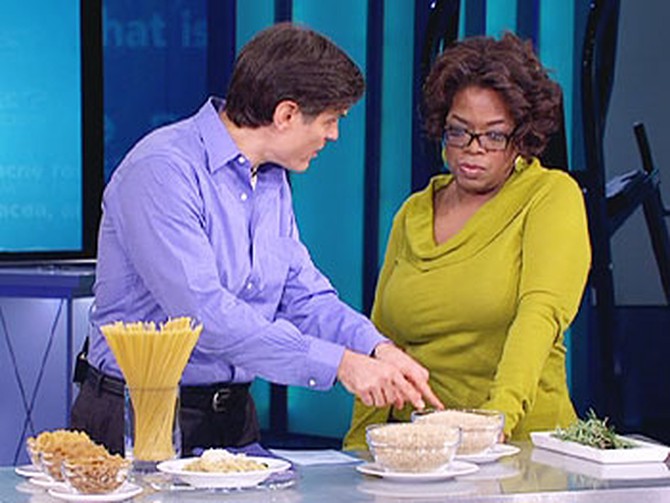
As Dr. Oz has said before, one key to staying young is to keep your intestines healthy and bowels regular. This takes plenty of fiber—about 25 grams a day. That's about two and a half times more than the average American eats a day. Fiber works by keeping all the nutrients you eat in your intestines and releases them as needed. So how can you increase your intake? Eat more fruits, vegetables and foods rich in whole grains.
Dr. Oz and Oprah both love steel-cut oatmeal, which takes a bit longer—10 to 20 minutes—to make than regular oatmeal. "The longer it takes the oatmeal, the more the fiber is going to benefit you," Dr. Oz says. "So be patient with it. It doesn't take that long."
Some other good fiber-rich options include beans, brown rice and whole grain pasta. When you're in the bread aisle at the grocery store, here's one thing to keep in mind to maximize your family's health. "Remember, you don't want it to say 'mixed grain,' 'great grain,' 'the best for you grain.' It's got to say '100 percent whole grain.' If it doesn't say 100 percent, it's not."
Dr. Oz and Oprah both love steel-cut oatmeal, which takes a bit longer—10 to 20 minutes—to make than regular oatmeal. "The longer it takes the oatmeal, the more the fiber is going to benefit you," Dr. Oz says. "So be patient with it. It doesn't take that long."
Some other good fiber-rich options include beans, brown rice and whole grain pasta. When you're in the bread aisle at the grocery store, here's one thing to keep in mind to maximize your family's health. "Remember, you don't want it to say 'mixed grain,' 'great grain,' 'the best for you grain.' It's got to say '100 percent whole grain.' If it doesn't say 100 percent, it's not."
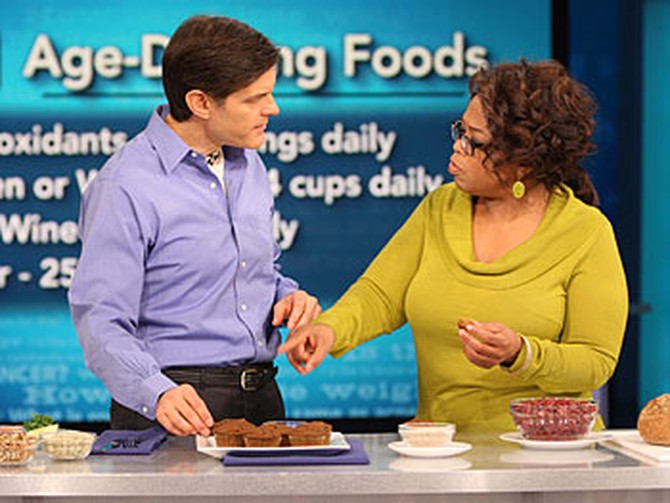
If you are trying to increase the fiber in your diet, you might want to consider steadily building up your intake rather than quickly ramping it up—otherwise, you could find yourself running for the bathroom.
"You can't go from the average in America of 10 to 12 grams of fiber to the 25 grams that a woman needs or the 35 that a male needs just like that. It's just too much all at once," Dr. Oz says. "Remember there are more bacteria in your intestines than there are cells in your body, so there are a lot of guys in there, and they're just trying to metabolize the food. So you give them a lot of fiber all at once, they're going to make a lot of gas out of it."
One intestinally gentle way to increase your fiber is by adding psyllium husks to your food. "If you're having a lot of foods like beans, you can add just a little bit of something called Beano. There are other products like it, but they provide enzymes—natural enzymes—that help your body get rid of some of the gaseous elements."
Another way to offset the gaseous side effects of a dramatic increase in fiber, Dr. Oz says, is by eating a Peruvian whole grain seed called chia—which is the same grain used to make Chia Pets—though you obviously shouldn't eat a Chia Pet.
Try this recipe for pumpkin chia-seed muffins.
Chia is as chockfull of fiber as other whole grains, but it packs in even more vitamins. "Remember that broccoli I had before? [One of these muffins] has more magnesium than about 10 of those heads of broccoli, and it's got as much calcium in it as a couple cups of milk," Dr. Oz says. "It adds one other thing, too, by the way. It's very rich in the next big category, which are omega-3 fatty acids."
"You can't go from the average in America of 10 to 12 grams of fiber to the 25 grams that a woman needs or the 35 that a male needs just like that. It's just too much all at once," Dr. Oz says. "Remember there are more bacteria in your intestines than there are cells in your body, so there are a lot of guys in there, and they're just trying to metabolize the food. So you give them a lot of fiber all at once, they're going to make a lot of gas out of it."
One intestinally gentle way to increase your fiber is by adding psyllium husks to your food. "If you're having a lot of foods like beans, you can add just a little bit of something called Beano. There are other products like it, but they provide enzymes—natural enzymes—that help your body get rid of some of the gaseous elements."
Another way to offset the gaseous side effects of a dramatic increase in fiber, Dr. Oz says, is by eating a Peruvian whole grain seed called chia—which is the same grain used to make Chia Pets—though you obviously shouldn't eat a Chia Pet.
Try this recipe for pumpkin chia-seed muffins.
Chia is as chockfull of fiber as other whole grains, but it packs in even more vitamins. "Remember that broccoli I had before? [One of these muffins] has more magnesium than about 10 of those heads of broccoli, and it's got as much calcium in it as a couple cups of milk," Dr. Oz says. "It adds one other thing, too, by the way. It's very rich in the next big category, which are omega-3 fatty acids."
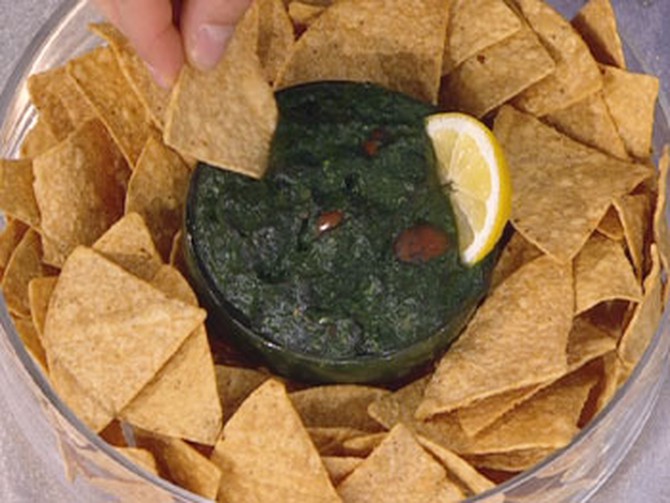
Another way to stay young that has gotten plenty of media attention lately is omega-3 fatty acids. If you're relying on flax seed for your omega-3s, Dr. Oz says you most likely need to roast or grind the seeds to release the oils. If you just eat them, you'd need to really chew them with your teeth, which is difficult to do. Other good sources include walnuts and hemp seeds.
One of the most widely reported sources of omega-3s is salmon. But recently many concerns have been raised about eating salmon—whether the fish is wild or farm-raised, worries about global sustainability, overfishing and rising mercury levels. The best way to get around these issues, Dr. Oz says, is to get to the source and eat what the salmon eat—spirolina algae, which has valuable DHA omega-3s. "We can avoid the issues of sustainability because we can get a ton of it," he says. "You can grow algae pretty easily, and it's a much more efficient way of getting it."
Get the recipe for Dr. Oz's guacamole made with spirulina algae.
One of the most widely reported sources of omega-3s is salmon. But recently many concerns have been raised about eating salmon—whether the fish is wild or farm-raised, worries about global sustainability, overfishing and rising mercury levels. The best way to get around these issues, Dr. Oz says, is to get to the source and eat what the salmon eat—spirolina algae, which has valuable DHA omega-3s. "We can avoid the issues of sustainability because we can get a ton of it," he says. "You can grow algae pretty easily, and it's a much more efficient way of getting it."
Get the recipe for Dr. Oz's guacamole made with spirulina algae.
Keep Reading

A crucial part of any well-rounded diet includes one or two tablespoons of olive oil a day in foods like salad dressing, Dr. Oz says.
One thing to keep in mind about olive oil is that you should not fry foods in it. "If you take a healthy fat and you fry it—if it reaches its smoking point—then you actually are oxidizing it," Dr. Oz says. "When you oxidize it, you actually damage the fats, so you lose a lot of the benefit."
Rather than putting the oil in the pan and heating it, a better method is to put the food in the oil first and then add it to a heated pan. "That's a wonderful way of reducing the amount of oxidation that occurs," he says.
One thing to keep in mind about olive oil is that you should not fry foods in it. "If you take a healthy fat and you fry it—if it reaches its smoking point—then you actually are oxidizing it," Dr. Oz says. "When you oxidize it, you actually damage the fats, so you lose a lot of the benefit."
Rather than putting the oil in the pan and heating it, a better method is to put the food in the oil first and then add it to a heated pan. "That's a wonderful way of reducing the amount of oxidation that occurs," he says.
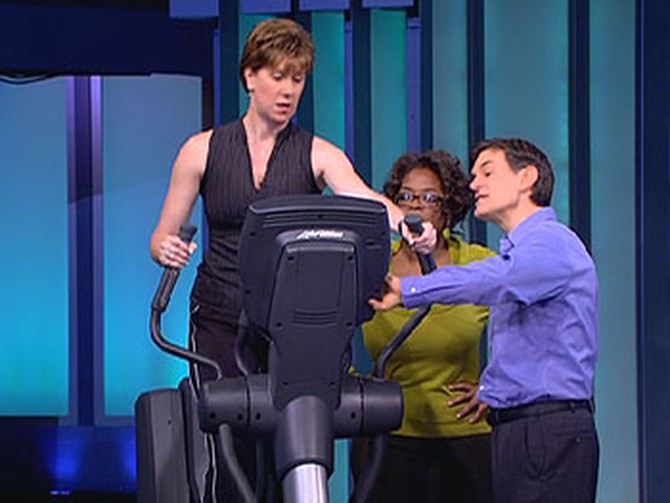
Now that we're eating right, it's time to get moving, too! Dr. Oz wants to emphasize that the focus of exercising should be to lose inches from your waist, not pounds off the scale. "When you start exercising and putting on muscle mass, you'll actually increase your weight a tiny bit, but your waist size will go down," he says. "You'll look better."
Maintaining weight as the years pass is a constant struggle, says 45-year-old Angela. "Every year, I just seem to see the scale going up and up with those years adding on. I'm exercising regularly. I'm eating a well-balanced diet. I feel like I should be at least maintaining. Not adding. Now I found myself with 15, 20 pounds to lose, and it just won't budge. Do you have any suggestions?"
Dr. Oz thinks Angela's problem is that she is not pushing herself hard enough. She needs to be working out at her target heart rate, which is 140.
The formula to find your ideal heart rate when exercising is 220 minus your age multiplied by 0.80.
Angela hops onto an elliptical machine for a cardiovascular workout at a level 6. Before long, she has already reached a heart rate of 140. "The fact you got there so quickly is a little bit of concern, because you shouldn't be able to get to your ideal heart rate so fast," Dr. Oz says. "You should be in better shape than that." To get in shape, Dr. Oz says Angela needs to work out at her target heart rate for 20 minutes, three times a week.
Maintaining weight as the years pass is a constant struggle, says 45-year-old Angela. "Every year, I just seem to see the scale going up and up with those years adding on. I'm exercising regularly. I'm eating a well-balanced diet. I feel like I should be at least maintaining. Not adding. Now I found myself with 15, 20 pounds to lose, and it just won't budge. Do you have any suggestions?"
Dr. Oz thinks Angela's problem is that she is not pushing herself hard enough. She needs to be working out at her target heart rate, which is 140.
The formula to find your ideal heart rate when exercising is 220 minus your age multiplied by 0.80.
Angela hops onto an elliptical machine for a cardiovascular workout at a level 6. Before long, she has already reached a heart rate of 140. "The fact you got there so quickly is a little bit of concern, because you shouldn't be able to get to your ideal heart rate so fast," Dr. Oz says. "You should be in better shape than that." To get in shape, Dr. Oz says Angela needs to work out at her target heart rate for 20 minutes, three times a week.
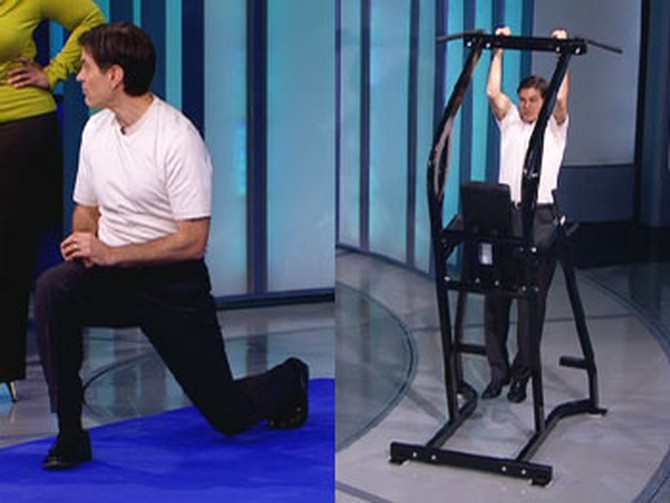
In addition to cardiovascular exercise, Dr. Oz says it is also important to build muscle mass through strength training. "Muscle burns 50 times more calories than fat does," Dr. Oz says.
Dr. Oz's first strength training exercise is the lunge, a simple exercise that is easy to do at home. "It's fundamentally important because it builds your lower body and your thighs. You want to lunge forward, get your knee as close to the ground as you can. Don't let the right knee pass over your toe."
Dr. Oz also recommends leg lifts. "This will strengthen the side muscles of the belly. You can do this. You can do all kinds of games with this. But it does strengthen your core muscles."
Strong core muscles will help you do pull-ups, another Dr. Oz-approved exercise. "The beauty of pull-ups is that when you're doing them, you're actually exercising your upper body, your arms, your torso. In the beginning, you might not be able to do it without something holding you up."
Dr. Oz says the combination of these exercises should be done three times a week.
Dr. Oz's first strength training exercise is the lunge, a simple exercise that is easy to do at home. "It's fundamentally important because it builds your lower body and your thighs. You want to lunge forward, get your knee as close to the ground as you can. Don't let the right knee pass over your toe."
Dr. Oz also recommends leg lifts. "This will strengthen the side muscles of the belly. You can do this. You can do all kinds of games with this. But it does strengthen your core muscles."
Strong core muscles will help you do pull-ups, another Dr. Oz-approved exercise. "The beauty of pull-ups is that when you're doing them, you're actually exercising your upper body, your arms, your torso. In the beginning, you might not be able to do it without something holding you up."
Dr. Oz says the combination of these exercises should be done three times a week.
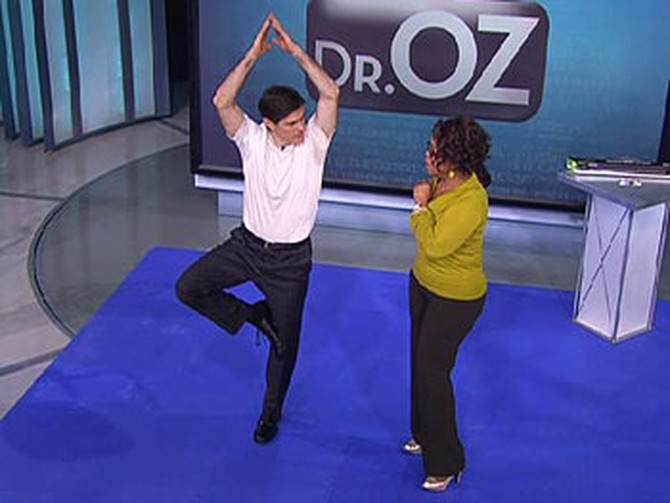
After you're revved up from cardio and strength training, Dr. Oz says to work on flexibility through yoga. Are you flexible enough? "Most Americans ought to be able to touch their fingertips to their toes," he says.
To start, Dr. Oz says to reach down to your toes. "So you lean over, relax yourself and let these hips sort of release," he says. "All the energy goes away." Next, Dr. Oz says to go into the plank position, followed by up dog, then down dog. Lastly, bring your leg forward and come up into the warrior position. "And you can do the exact same thing for the other side," Dr. Oz says. "It's very soothing, and that meditation is very powerful."
See Dr. Oz's full guide to yoga.
To start, Dr. Oz says to reach down to your toes. "So you lean over, relax yourself and let these hips sort of release," he says. "All the energy goes away." Next, Dr. Oz says to go into the plank position, followed by up dog, then down dog. Lastly, bring your leg forward and come up into the warrior position. "And you can do the exact same thing for the other side," Dr. Oz says. "It's very soothing, and that meditation is very powerful."
See Dr. Oz's full guide to yoga.

Dr. Oz says there is something you can do for five minutes every day that can add years to your life—meditation. Just find a quiet place, even if it's the bathroom. "No one's going to bother you there," he says. "You can get five minutes of solace, of peace and quiet."
To start your meditation, Dr. Oz says to say the word "yum," drawing out the word out as you say it. "That vibration stimulates your sinuses to release nitric oxide, a very important gas that relaxes your lungs and relaxes your blood vessels," he says. "It's one of the reasons we think meditation may be so effective."
Dr. Oz says there are other ways to practice meditation as well. "Prayer is meditation," he says. "Just a few moments to yourself, not a lot, when no one can bother you to let it all slip away. It allows you to reboot your engine and get back on track."
To start your meditation, Dr. Oz says to say the word "yum," drawing out the word out as you say it. "That vibration stimulates your sinuses to release nitric oxide, a very important gas that relaxes your lungs and relaxes your blood vessels," he says. "It's one of the reasons we think meditation may be so effective."
Dr. Oz says there are other ways to practice meditation as well. "Prayer is meditation," he says. "Just a few moments to yourself, not a lot, when no one can bother you to let it all slip away. It allows you to reboot your engine and get back on track."
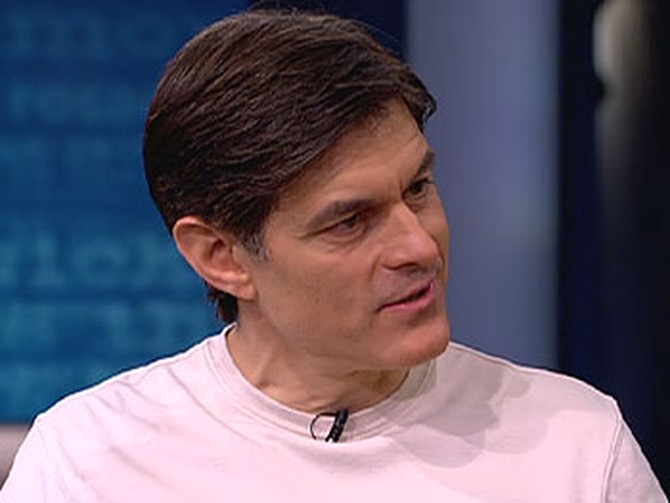
There is something lacking in the bedroom that Dr. Oz says is aging us at warp speed. "We're not sleeping. And sleeping is the fundamental way we reboot ourselves." Dr. Oz says the growth hormone, which is important for maintaining vitality and youthful vigor, is almost impossible to increase naturally without sleep. "Without the sleep that we know is so nourishing, we begin to dramatically age faster. It strips years off of our 'real age.'"
Before bedtime, Dr. Oz says to clean up and remember to floss. "Don't forget that. That will take two to five years off your 'real age' because of gingivitis and irritation of the gums that occurs if you don't floss your teeth."
The next step is to relax. "When you get in the bed, turn the lights down, do something that's soothing. Turn off the TV, turn off the computer. Don't do things that jazz you back up again, and you will find yourself gently slipping into sleep."
Before bedtime, Dr. Oz says to clean up and remember to floss. "Don't forget that. That will take two to five years off your 'real age' because of gingivitis and irritation of the gums that occurs if you don't floss your teeth."
The next step is to relax. "When you get in the bed, turn the lights down, do something that's soothing. Turn off the TV, turn off the computer. Don't do things that jazz you back up again, and you will find yourself gently slipping into sleep."
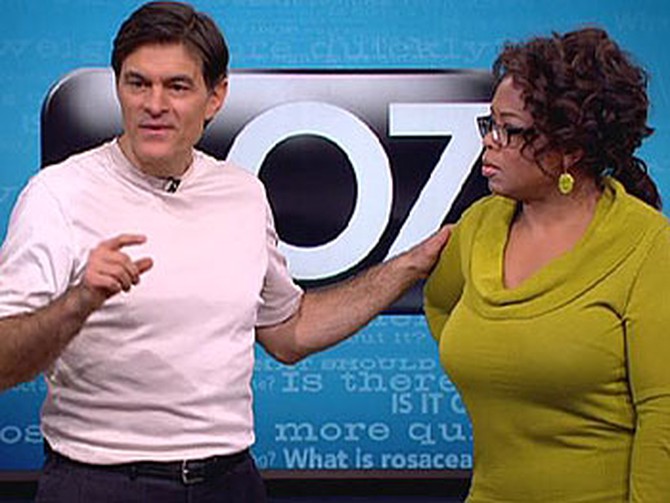
In addition to lack of sleep, Dr. Oz says we're deprived of something else in the bedroom— sex. "The average American has sex 58 times a year—so, once a week. If you double that, you reduce your 'real age' by almost three years."
Dr. Oz says sex creates an increase in chemicals that keep us young. "When you have loving conjugal love with someone and you actually have that passionate moment, you not only exchange bodily chemicals, but you make chemicals within you," he says. "So women get oxytocin increases, which give you that loving bond that you want with the world around you and people around you. Men have an increase in testosterone. Testosterone is what puts the moan in hormone. It sort of gets you going."
Dr. Oz says sex creates an increase in chemicals that keep us young. "When you have loving conjugal love with someone and you actually have that passionate moment, you not only exchange bodily chemicals, but you make chemicals within you," he says. "So women get oxytocin increases, which give you that loving bond that you want with the world around you and people around you. Men have an increase in testosterone. Testosterone is what puts the moan in hormone. It sort of gets you going."
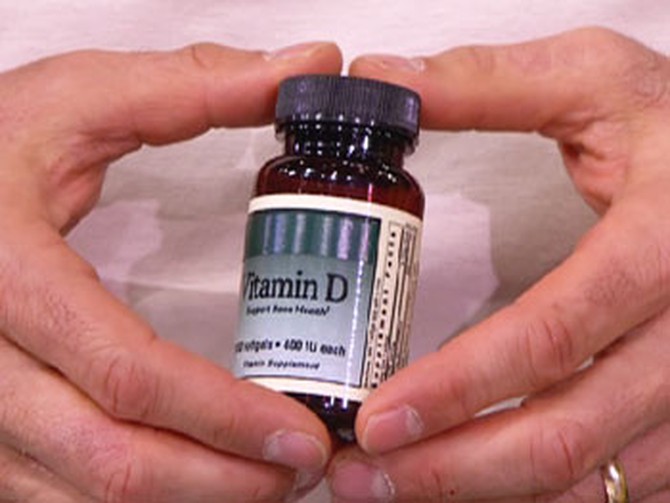
The last category on Dr. Oz's anti-aging checklist is vitamins. First up is vitamin D. "We estimate that over half of all Americans are deficient in vitamin D," Dr. Oz says.
Dr. Oz says 1,000 units of vitamin D a day will benefit the body in a variety of ways. "Vitamin D is critically important for preventing cancer and critically important for reducing heart problems. It's linked to multiple sclerosis, to juvenile diabetes. It's one of the best ways of reducing infection rates. It's got a ton of things that it does for you to make your immune system function the way you want it to function."
Your body naturally gets vitamin D through sunlight exposure, so Dr. Oz says to get 10 minutes of direct sun exposure to your body or take a vitamin D supplement once a day.
Dr. Oz says 1,000 units of vitamin D a day will benefit the body in a variety of ways. "Vitamin D is critically important for preventing cancer and critically important for reducing heart problems. It's linked to multiple sclerosis, to juvenile diabetes. It's one of the best ways of reducing infection rates. It's got a ton of things that it does for you to make your immune system function the way you want it to function."
Your body naturally gets vitamin D through sunlight exposure, so Dr. Oz says to get 10 minutes of direct sun exposure to your body or take a vitamin D supplement once a day.
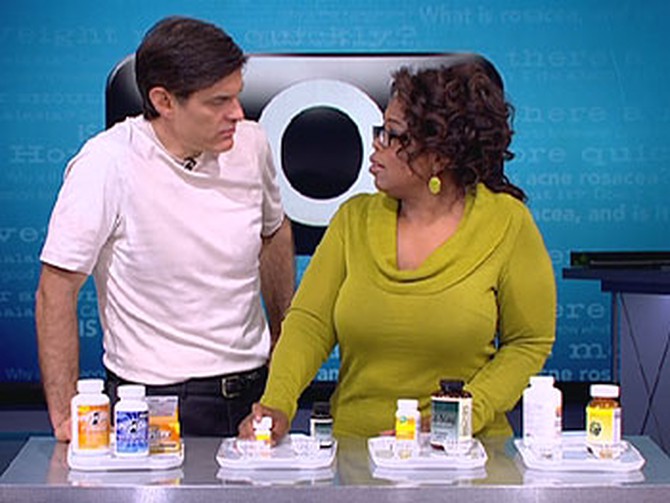
Another important supplement to include with your daily vitamins is calcium, but Dr. Oz says to always take it with magnesium. If you don't, you may regret it. "A little constipation," he says.
"You want to take calcium, but you've got to take it with magnesium because if you don't take them together, the magnesium loosens your poop," he says. "The calcium makes it a little bit like concrete." Dr. Oz recommends taking 600 milligrams of calcium and 200 milligrams of magnesium twice daily.
Dr. Oz says the next vitamin on his list is often forgotten: DHA omega-3. Dr. Oz says a dose of DHA omega-3 is similar to fish oil but comes in a small pill form. "It comes from a source that we know is pretty clean and doesn't give you the anti-coagulant problems that sometimes you run into with fish oil, so I think DHA omega 3s make a lot of sense," Dr. Oz says. He recommends taking 600 milligrams a day.
If you're over the age of 40, Dr. Oz recommends adding two baby aspirins to your daily regime. "We know it's very effective in reducing heart disease, very effective in reducing cancer. We think it might actually reduce wrinkles. There's a lot of things aspirin might do that are beneficial to you not only because it thins your blood, but it's a very powerful anti-inflammatory drug."
Just be sure to take two baby aspirin, not regular aspirin. "A regular aspirin is 325 milligrams," Dr. Oz says. "Two babies is 162. So it's half a regular aspirin. The more aspirin you take, the more chances you might have some intestinal discomfort."
"You want to take calcium, but you've got to take it with magnesium because if you don't take them together, the magnesium loosens your poop," he says. "The calcium makes it a little bit like concrete." Dr. Oz recommends taking 600 milligrams of calcium and 200 milligrams of magnesium twice daily.
Dr. Oz says the next vitamin on his list is often forgotten: DHA omega-3. Dr. Oz says a dose of DHA omega-3 is similar to fish oil but comes in a small pill form. "It comes from a source that we know is pretty clean and doesn't give you the anti-coagulant problems that sometimes you run into with fish oil, so I think DHA omega 3s make a lot of sense," Dr. Oz says. He recommends taking 600 milligrams a day.
If you're over the age of 40, Dr. Oz recommends adding two baby aspirins to your daily regime. "We know it's very effective in reducing heart disease, very effective in reducing cancer. We think it might actually reduce wrinkles. There's a lot of things aspirin might do that are beneficial to you not only because it thins your blood, but it's a very powerful anti-inflammatory drug."
Just be sure to take two baby aspirin, not regular aspirin. "A regular aspirin is 325 milligrams," Dr. Oz says. "Two babies is 162. So it's half a regular aspirin. The more aspirin you take, the more chances you might have some intestinal discomfort."
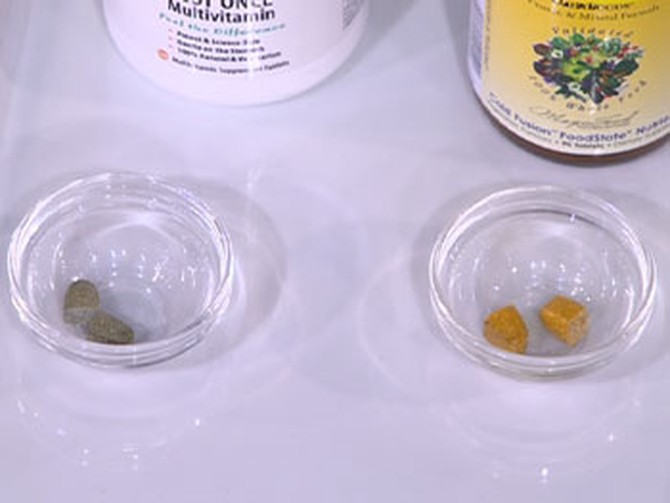
The last vitamin on Dr. Oz's list is the all-important multivitamin. Dr. Oz says this vitamin should be cut in half so you have two doses. "If you divide the vitamin in half, then you stabilize your dose during the day. Take half in the morning, half in the evening."
Dr. Oz says taking a full multivitamin in one dose is like over-filling your tank. "You want to give your body the right amount of fuel for when you need it. Vitamins have water soluble elements to them so they are quickly moved through your system."
If you're confused about which multivitamin is right for you depending on your age and sex, Dr. Oz says to keep it simple. "Everyone takes the basic same multivitamin with two small exceptions," he says. Pre-menopausal women should take a multivitamin with iron in it and 5,000 units of vitamin A. Men and post-menopausal women can take a basic multivitamin with 2,500 units of vitamin A.
When taking your daily vitamins, Dr. Oz says to make sure to get plenty of fluids. "Wash them down, especially the aspirin," he says. "If you don't like taking the pills, you can get liquid vitamins. They work as well. Find something that agrees with you that you can automatically make part of everyday life for you."
Need an age-specific guide to vitamins? Print Dr. Oz's vitamin checklist for your age group.
Dr. Oz says taking a full multivitamin in one dose is like over-filling your tank. "You want to give your body the right amount of fuel for when you need it. Vitamins have water soluble elements to them so they are quickly moved through your system."
If you're confused about which multivitamin is right for you depending on your age and sex, Dr. Oz says to keep it simple. "Everyone takes the basic same multivitamin with two small exceptions," he says. Pre-menopausal women should take a multivitamin with iron in it and 5,000 units of vitamin A. Men and post-menopausal women can take a basic multivitamin with 2,500 units of vitamin A.
When taking your daily vitamins, Dr. Oz says to make sure to get plenty of fluids. "Wash them down, especially the aspirin," he says. "If you don't like taking the pills, you can get liquid vitamins. They work as well. Find something that agrees with you that you can automatically make part of everyday life for you."
Need an age-specific guide to vitamins? Print Dr. Oz's vitamin checklist for your age group.
Published 03/14/2008
As a reminder, always consult your doctor for medical advice and treatment before starting any program.




